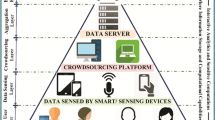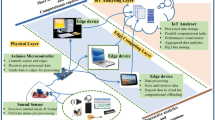Abstract
Device centric music computation in the era of the Internet is participant-centric data recognition and computation that includes devices such as smartphones, real sound sensors, and computing systems. These participatory devices enhance the progression of Internet of Things, the devices which are responsible for gathering sensor data to the devices as per the requirements of the end users. This contribution analyzes a class of qualitative music composition applications in the context of the Internet of Things that we entitle as the Internet of Music Things. In this work, participated individuals having sensing devices capable of music sensing and computation share data within a group and retrieve information for analyzing and mapping any interconnected processes of common interest. We present the crowdsensing architecture for music composition in this contribution. Musical components like vocal and instrumental performances are provided by a committed edge layer in music crowdsensing architecture for improving computational efficiencies and lessening data traffic in cloud services for information processing and storage. Proposed opportunistic music crowdsensing orchestration organizes a categorical step toward aggregated music composition and sharing within the network. We also discuss an analytical case study of music crowdsensing challenges, clarify the unique features, and demonstrate edge-cloud computing paradigm along with deliberate outcomes. The requirement for four-layer unified crowdsensing archetype is discussed. The data transmission time, power, and relevant energy consumption of the proposed system are analyzed.











Similar content being viewed by others
References
Jian A, Gui X, Yang J, Sun Y, He X (2015) Mobile crowd sensing for internet of things: A credible crowdsourcing model in mobile-sense service. In: Multimedia Big Data (BigMM), IEEE International Conference, pp 92-99. https://doi.org/10.1109/BigMM.2015.62
Ganti RK, Fan Y, Hui L (2011) Mobile crowdsensing: current state and future challenges. IEEE Commun Mag. https://doi.org/10.1109/MCOM.2011.6069707
Sun Y, Houbing S, Antonio JJ, Rongfang B (2016) Internet of things and big data analytics for smart and connected communities. IEEE Access 4:766–773. https://doi.org/10.1109/ACCESS.2016.2529723
Arkian HR, Abolfazl D, Atefe P (2017) MIST: Fog-based data analytics scheme with cost-efficient resource provisioning for IoT crowdsensing applications. J Netw Comput Appl 82:152–165. https://doi.org/10.1016/j.jnca.2017.01.012
Durao F, Carvalho JFS, Fonseka A, Garcia VC (2014) A systematic review on cloud computing. J Supercomput 68:1321–1346. https://doi.org/10.1007/s11227-014-1089-x
Diaz M, Martin C, Rubio B (2016) State-of-the-art, challenges, and open issues in the integration of Internet of things and cloud computing. J Netw Comput Appl 67:99–117. https://doi.org/10.1016/j.jnca.2016.01.010
Cavalcante E, Pereira J, Alves MP, Maia P (2016) On the interplay of internet of things and cloud computing: a systematic mapping study. J Comput Commun 89(9):17–33. https://doi.org/10.1016/j.comcom.2016.03.012
Roy DG, De D, Mukherjee A, Buyya R (2017) Application-aware cloudlet selection for computation offloading in multi-cloudlet environment. J Supercomput 73(4):1672–1690. https://doi.org/10.1007/s11227-016-1872-y
Mahmud R, Kotagiri R, Buyya R (2018) Fog computing: a taxonomy, survey and future directions. In: Di Martino B, Li KC, Yang L, Esposito A (eds) Internet of everything. Internet of things (technology, communications and computing). Springer, Singapore, pp 103–130. https://doi.org/10.1007/978-981-10-5861-5_5
Agarwal S, Yadav S, Yadav AK (2016) An efficient architecture and algorithm for resource provisioning in fog computing. Int J Inf Eng Electron Bus 8(1):48. https://doi.org/10.5815/ijieeb.2016.01.06
Alzamil I, Djemame K, Armstrong D, Kavanagh R (2015) Energy-aware profiling for cloud computing environments. Electron Notes Theor Comput Sci 318:91–108. https://doi.org/10.1016/j.entcs.2015.10.021
Krishnan AS, Xiping H, Jun-qi D, Renfei W, Min L, Chunsheng Z, Victor CML, Yu-Kwong K (2015) A novel cloud-based crowd sensing approach to context-aware music mood-mapping for drivers. In: Cloud computing technology and science (CloudCom), pp 475–478. https://doi.org/10.1109/CloudCom.2015.85
Hu X (2015) A platform for building context-aware mobile crowdsensing applications in vehicular social networks. PhD diss., University of British Columbia. https://doi.org/10.14288/1.0216020
Obinikpo A, Yuan Z, Houbing S, Tom HL, Burak K (2017) Queuing algorithm for effective target coverage in mobile crowd sensing. IEEE Internet Things J. https://doi.org/10.1109/JIOT.2017.2688366
Song S, Sunae S, Younghwan J, Seoungjin L, Baek-Young C (2015) Effective opportunistic crowd sensing IoT system for restoring missing objects. In: Services Computing (SCC), IEEE International Conference on, pp 293–300. https://doi.org/10.1109/SCC.2015.48
Alvaro JL, Barros B (2013) A new cloud computing architecture for music composition. J Netw Comput Appl 36(1):429–443. https://doi.org/10.1016/j.jnca.2012.04.015
Roy S, Bhakta P, De D, Chakrabarty S (2014) Modeling high performance music computing using Petri Nets. In: Control, instrumentation, energy and communication (CIEC), IEEE, pp 678–682. https://doi.org/10.1109/CIEC.2014.6959176
Deng F, Guan S, Yue X, Gu X, Chen J, Lv J, Li J (2017) Energy-based sound source localization with low power consumption in wireless sensor networks. IEEE Trans Ind Electron. https://doi.org/10.1109/TIE.2017.2652394
Bonomi F, Milito R, Natarajan P, Zhu J (2014) Fog computing: a platform for internet of things and analytics. In: Big data and internet of things: a roadmap for smart environments. Springer International Publishing, pp 169–186. https://doi.org/10.1007/978-3-319-05029-4_7
Hong HJ, Ching-Ling F, Yen-Chen L, Cheng-Hsin H (2016) Optimizing cloud-based video crowdsensing. IEEE Internet Things J 3(3):299–313. https://doi.org/10.1109/JIOT.2016.2519502
Sheng H, Jian T, Xuejie X, Guoliang X (2014) Leveraging GPS-less sensing scheduling for green mobile crowd sensing. IEEE Internet Things J 1(4):328–336. https://doi.org/10.1109/JIOT.2014.2334271
Antonić A, Martina M, Krešimir P, Ivana PZ (2016) A mobile crowd sensing ecosystem enabled by CUPUS: Cloud-based publish/subscribe middleware for the internet of things. Future Gener Comput Syst 56:607–622. https://doi.org/10.1016/j.future.2015.08.005
Sarkar S, Misra S (2016) Theoretical modelling of fog computing: a green computing paradigm to support IoT applications. IET Netw 5(2):23–29. https://doi.org/10.1049/iet-net.2015.0034
Tortonesi M, Michaelis J, Suri N, Baker M (2016) Software-defined and value-based information processing and dissemination in IoT applications. In: Network operations and management symposium (NOMS), IEEE/IFIP, pp 789–793. https://doi.org/10.1109/NOMS.2016.7502900
Yang J, Li J, Liu S (2018) A new algorithm of stock data mining in internet of multimedia things. J Supercomput. https://doi.org/10.1007/s11227-017-2195-3
Zanella A, Bui N, Castellani Vangelista L, Zorzi M (2014) Internet of things for smart cities. IEEE Internet Things J 1(1):22–32. https://doi.org/10.1109/JIOT.2014.2306328
Vakintis I, Panagiotakis S, Mastorakis G, Mavromoustakis CX (2016) Evaluation of a Web crowd-sensing IoT ecosystem providing Big data analysis. In: Resource management for big data platforms, Springer International Publishing, pp 461–488. https://doi.org/10.1007/978-3-319-44881-7_22
Sarkar S, Chatterjee S, Misra S (2015) Assessment of the suitability of fog computing in the context of internet of things. IEEE Trans Cloud Comput. https://doi.org/10.1109/TCC.2015.2485206
Zhou J, Leppanen T, Harjula E, Ylianttila M, Ojala T, Yu C, Jin H, Yang LT (2013) Cloudthings: a common architecture for integrating the internet of things with cloud computing. In: Computer Supported Cooperative Work in Design (CSCWD), IEEE 17th International Conference, IEEE, pp 651–657. https://doi.org/10.1109/CSCWD.2013.6581037
Yamamoto H, Kuriyama Y (2017) Ishii H (2017) Estimating the processing time of a model of cloud computing. J Supercomput 73:2483–2493. https://doi.org/10.1007/s11227-016-1940-3
Varghese B, Buyya R (2018) Next generation cloud computing: new trends and research directions. Future Gener Comput Syst 79:849–861. https://doi.org/10.1016/j.future.2017.09.020
Mukherjee A, Deb P, De D, Buyya R (2018) C2OF2 N: a low power cooperative code offloading method for femtolet-based fog network. J Supercomput. https://doi.org/10.1007/s11227-018-2269-x
Roy S, Chakrabarty S, De D (2017) Time-based raga recommendation and information retrieval of musical patterns in Indian classical music using neural networks. IAES Int J Artif Intell (IJ-AI) 6(1):33–48. https://doi.org/10.11591/ij-ai.v6.i1.pp33-48
Alamri A, Ansari WS, Hassan MM, Hossain MS, Alelaiwi A, Hossain MA (2013) A survey on sensor-cloud: architecture, applications and approaches. Int J Distrib Sens Netw 9(2):917923. https://doi.org/10.1155/2013/917923
You SD, Lin YC (2016) Simulated smart phone recordings for audio identification. J Supercomput 72(5):1799–1812. https://doi.org/10.1007/s11227-015-1533-6
Khorasani F, Naji HR (2017) Energy efficient data aggregation in wireless sensor networks using neural networks. Int J Sens Netw 24(1):26–42. https://doi.org/10.1504/IJSNET.2017.084207
Varia J, Mathew S (2014) Overview of amazon web services. https://aws.amazon.com. pp 1–22. Accessed 20 Nov 2017
Jackson KR, Ramakrishnan L, Muriki K, Canon S, Cholia S, Shalf J, Wasserman HJ and Wright NJ (2010) Performance analysis of high performance computing applications on the amazon web services cloud. In: Cloud Computing Technology and Science (CloudCom). IEEE Second International Conference. pp 159–168. https://doi.org/10.1109/CloudCom.2010.69
Wang Y, Jia X, Jin Q, Ma J (2015) QuaCentive: a quality-aware incentive mechanism in mobile crowdsourced sensing (MCS). J Supercomput. https://doi.org/10.1007/s11227-015-1395-y
Amazon Web Service, https://docs.aws.amazon.com/AWSEC2/latest/UserGuide/putty.html. Accessed 17 Jan 2018
Acknowledgements
Authors are grateful to the University Grant Commission (UGC), Govt. of India, for sanctioning a research fellowship under NFOBC scheme with Ref. No.: F./2016-17/NFO-2015-17-OBC-WES-34371 under which this contribution has been completed. Authors are also grateful to the Department of Science and Technology (DST) for sanctioning a project with Ref. No. DST FIST SR/FST/ETI-296/2011 and TEQIP-III, MAKAUT, WB.
Author information
Authors and Affiliations
Corresponding author
Rights and permissions
About this article
Cite this article
Roy, S., Sarkar, D., Hati, S. et al. Internet of Music Things: an edge computing paradigm for opportunistic crowdsensing. J Supercomput 74, 6069–6101 (2018). https://doi.org/10.1007/s11227-018-2511-6
Published:
Issue Date:
DOI: https://doi.org/10.1007/s11227-018-2511-6




